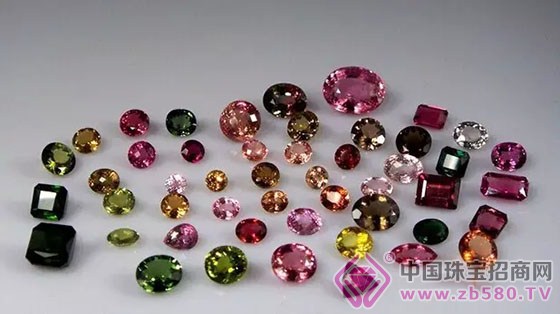
Bixi's identification of "love and hate"
Some time ago, with the prosperity of the Caibao market, the popularity of the merchants, the domestic tourmaline price rose sharply. For jewellery appraisers, it is followed by a doubling of the detection of tourmaline jewelry.
At the same time, the identification of tourmalines and many similar products and the identification of various optimization methods have begun to plague the inspectors, making people "love and hate."
"Love" of the tourmaline identification
- the most colorful rainbow gemstone
Tourmaline is the most colorful gemstone, and the colors in the spectrum can be found in the tourmaline.
Paraiba Tourmaline
The richness of the tourmaline color is due to its chemical composition, and the quality of the tourmaline is usually divided by color and special optical effects:
Red series: rich in manganese, of which the pure red tourmaline is the most expensive.
Green series: rich in chrome and dark green as an emerald substitute. Yellow green value is low.
Yellow series: rich in iron and titanium, the most precious is the "canary".
Tourmaline cat's eye: a tourmaline showing cat's eye effect, mostly green, occasionally blue or pink.
Paraiba Tourmaline: A blue or green neon-like enamel color that contains copper and zinc. Because it is very rare and expensive, the wholesale price of more than 3 carats Paraiba can reach 10,000 US dollars / carat.
Yellow tourmaline
There are also colorless tourmalines, black tourmalines, brown tourmalines, etc., which are relatively inexpensive.
Multicolor tourmaline: including watermelon tourmaline, tricolor tourmaline and so on.
Watermelon tourmaline
Identification of "hate"
——The distinction of many similar varieties
Cat's eye tourmaline
The variety of tourmalines has led to a variety of gemstones that are more confusing, and there are multiple gemstones in different colors. Commonly confusing natural gemstone varieties such as:
Colorless tourmaline: colorless crystal, colorless beryl, colorless topaz, etc.
Green tourmaline: epidote, diopside, green beryl, etc.
Red tourmaline: pink crystal, garnet, etc.
Yellow tourmaline: citrine, Fushan stone, meteorite, etc.
For the detection of tourmaline, the variety can be determined by observing the obvious pleochroism of tourmaline, magnifying and inspecting the characteristic tubular inclusions, and obvious ghosting of the rear facet.
Champagne tourmaline
(Item No.: A0922-N7)
One of the most problematic "hate" by the inspectors: in the colorful necklaces or bracelets of the tourmaline, there are a variety of other gemstones.
The magnifying inspection alone cannot accurately and efficiently carry out the classification of the variety. It is usually necessary to use an infrared spectrometer to detect one dozen or even hundreds of beaded birch ornaments one by one, challenging the intimacy and patience of the inspectors. Only by observing the infrared spectrum of various colors and the various gemstone maps, the inspectors can complete the initial inspection work relatively quickly and accurately - determine the species of the tourmaline gemstone.
Yellow, green tourmaline
(Item No.: A0822-N6)
In addition to mixing other low-grade gemstones in the tourmaline jewelry, the worse case will also see the use of various colored stained glass to impersonate the tourmaline.
This kind of sample for inspection is more common in samples sent by scattered customers. It is a sample recently received by NGTC Laboratories. The customer spent several thousand yuan to purchase the “Bixi†necklace. After testing, the result is dyed glass.
Woven Fabric,Woven Polyester Lining Dress Fabric,Woven Cloth Fabric,Pp Non Woven Fabric
Shaoxing Ruier Imp. & Exp. Co.,Ltd , https://www.pasatextiles.com